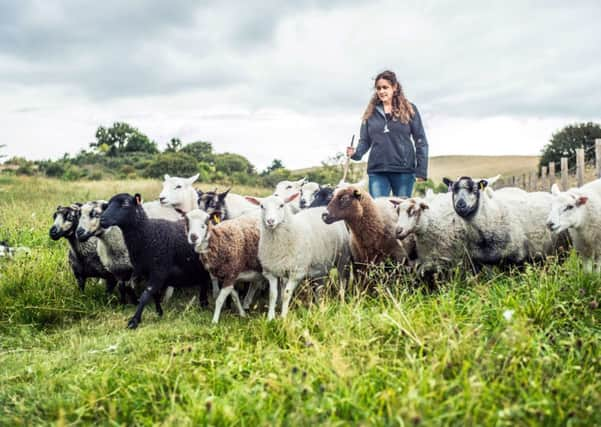Farms reap reward of cutting emissions


Meeting the Scottish Government’s 2020 target for reducing greenhouse gas emissions by at least 42 per cent involves everyone, not least the food and agriculture industries.
The issue of methane emissions from livestock, for example, has been well documented, although often with the common misconception that methane comes from a cow’s backside when most is actually burped out!
Advertisement
Hide AdAdvertisement
Hide AdEncouragingly, however, the first stage of an initiative managed by Scotland’s Rural College (SRUC) has shown that cutting a farm’s carbon footprint can be more practical and profitable than many think.
Three farms involved in the Scottish Government’s three-year Farming for a Better Climate initiative saved almost £60,000 between them. Despite challenging weather conditions over the period, Torr Farm near Castle Douglas and Glenkilrie below Glenshee improved efficiency and reduced their carbon footprint by at least 10 per cent. Future reductions are expected at Stewart Tower by Stanley. A fourth farm, in the Borders, still has one year left to run.
These “Focus Farms” have helped local farmer discussion groups explore practical ways to reduce local farming’s carbon footprint. With no single answer to the challenge, the volunteer farmers were chosen to reflect differences in farm type and region.
At Torr in the south west, Ross Paton and sister Lee manage a 420-hectare organic dairy farm with 170 cows. Ross found the project fascinating.
“The group exchanged many practical ideas, some of which we had not thought about before,” he said.
“Many of the low carbon actions we explored we were able to implement. It is possible to reduce greenhouse gas emissions and save money, providing you tighten up management practices and don’t waste resources.”
Through measures like installing a SMART meter, saving hot water and the correct calibration of equipment, electricity demand was cut by 21 per cent, saving 13.3 tonnes of CO2. They cut fuel use by 33 per cent. For Ross the most useful things investigated concerned his soil and nutrient management.
“Being an organic farm, it is important to use the nutrients in the cows dung efficiently,” Ross said. “After analysing our soils and slurry, we created a nutrient budget and applied the slurry to the land in a more precise way. A new slurry store allows us to keep more for the spring, when the crops are growing and will take up the nutrients.”
Advertisement
Hide AdAdvertisement
Hide AdProducing quality milk from grass and home-grown feed needs soil with a good structure and drainage. Managing poorly drained areas is essential. Following expert guidance Ross now regularly checks his soil structure by digging pits. If there are no earthworms or the root depth is poor, it could indicate compaction needing remedial action.
They are already seeing the benefit in increased yields on land where they renewed the existing drainage system.
In Perthshire, David Houstoun farms Glenkilrie, an upland beef and sheep farm of nearly 1,000ha with 140 suckler cows and 1,000 ewes.
Once again it was attention to detail. By bedding his cattle on recycled woodchips he saved £960 in straw costs and the equivalent of over two tonnes of CO2, with less labour. Examining fuel use on his quad bike, he noted converting to electricity would cost £1,100 less per year and reduce carbon.
For David a key step was calving his cows at two years old instead of nearly three.
“I was sceptical when it was suggested at the first meeting, but I am delighted with the results,” he said.
“Per calf born, we saved several months in the cost of feed and the energy used to produce it and manage the cows. The younger cows are fitter and we get an extra 20 calves a year from the herd.”
Meanwhile, for David’s family an interesting part of the project was the idea of heating the old-fashioned farmhouse with a biomass boiler.
Advertisement
Hide AdAdvertisement
Hide AdIt’s not just farmers who are considering ways to cut their carbon footprint, the general public are also being asked to contribute.
At Stewart Tower, Neil and Linsey Butler explain to those visiting their farm shop and ice-cream parlour what is happening on the other Focus Farms and how agriculture is contributing to cutting greenhouse gas emissions.
Neil said: “People have been interested to hear what the sector is doing. We have had information up in the shop and visitors have asked me about it with genuine interest.
“Before the project, we were focusing on some of the areas that have been highlighted. For example, we have a carbon footprint as part of our milk contract with Sainsbury’s. Through the initiative, we looked at other areas like increasing more nitrogen-fixing clover in our grass to cut inorganic fertiliser use.
One of the things learned from these projects is the cumulative benefits add up, and not only for a farm. If all farmers took up similar measures, it could mean a lower carbon footprint in agriculture across Scotland.”
The project is progressing with new Focus Farms but has already shown that, even on already technically efficient farms, there is still scope to improve efficiency, save money and reduce farming’s emissions.
• Rebecca Audsley is senior consultant at Scotland’s Rural College. www.sruc.ac.uk